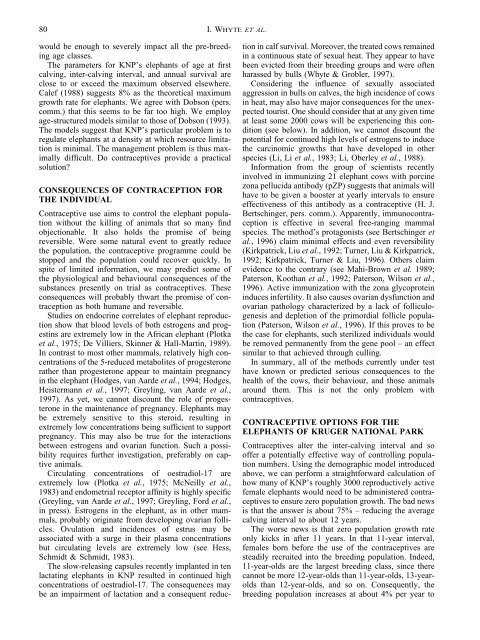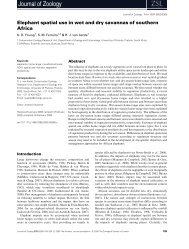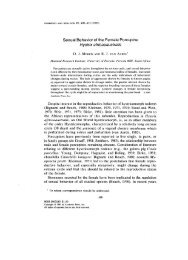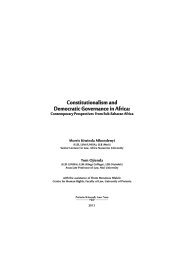Managing the elephants of Kruger National Park - CERU - University ...
Managing the elephants of Kruger National Park - CERU - University ...
Managing the elephants of Kruger National Park - CERU - University ...
You also want an ePaper? Increase the reach of your titles
YUMPU automatically turns print PDFs into web optimized ePapers that Google loves.
80 I. WHYTE ET AL.<br />
would be enough to severely impact all <strong>the</strong> pre-breeding<br />
age classes.<br />
The parameters for KNP’s <strong>elephants</strong> <strong>of</strong> age at first<br />
calving, inter-calving interval, and annual survival are<br />
close to or exceed <strong>the</strong> maximum observed elsewhere.<br />
Calef (1988) suggests 8% as <strong>the</strong> <strong>the</strong>oretical maximum<br />
growth rate for <strong>elephants</strong>. We agree with Dobson (pers.<br />
comm.) that this seems to be far too high. We employ<br />
age-structured models similar to those <strong>of</strong> Dobson (1993).<br />
The models suggest that KNP’s particular problem is to<br />
regulate <strong>elephants</strong> at a density at which resource limitation<br />
is minimal. The management problem is thus maximally<br />
difficult. Do contraceptives provide a practical<br />
solution?<br />
CONSEQUENCES OF CONTRACEPTION FOR<br />
THE INDIVIDUAL<br />
Contraceptive use aims to control <strong>the</strong> elephant population<br />
without <strong>the</strong> killing <strong>of</strong> animals that so many find<br />
objectionable. It also holds <strong>the</strong> promise <strong>of</strong> being<br />
reversible. Were some natural event to greatly reduce<br />
<strong>the</strong> population, <strong>the</strong> contraceptive programme could be<br />
stopped and <strong>the</strong> population could recover quickly. In<br />
spite <strong>of</strong> limited information, we may predict some <strong>of</strong><br />
<strong>the</strong> physiological and behavioural consequences <strong>of</strong> <strong>the</strong><br />
substances presently on trial as contraceptives. These<br />
consequences will probably thwart <strong>the</strong> promise <strong>of</strong> contraception<br />
as both humane and reversible.<br />
Studies on endocrine correlates <strong>of</strong> elephant reproduction<br />
show that blood levels <strong>of</strong> both estrogens and progestins<br />
are extremely low in <strong>the</strong> African elephant (Plotka<br />
et al., 1975; De Villiers, Skinner & Hall-Martin, 1989).<br />
In contrast to most o<strong>the</strong>r mammals, relatively high concentrations<br />
<strong>of</strong> <strong>the</strong> 5-reduced metabolites <strong>of</strong> progesterone<br />
ra<strong>the</strong>r than progesterone appear to maintain pregnancy<br />
in <strong>the</strong> elephant (Hodges, van Aarde et al., 1994; Hodges,<br />
Heistermann et al., 1997; Greyling, van Aarde et al.,<br />
1997). As yet, we cannot discount <strong>the</strong> role <strong>of</strong> progesterone<br />
in <strong>the</strong> maintenance <strong>of</strong> pregnancy. Elephants may<br />
be extremely sensitive to this steroid, resulting in<br />
extremely low concentrations being sufficient to support<br />
pregnancy. This may also be true for <strong>the</strong> interactions<br />
between estrogens and ovarian function. Such a possibility<br />
requires fur<strong>the</strong>r investigation, preferably on captive<br />
animals.<br />
Circulating concentrations <strong>of</strong> oestradiol-17 are<br />
extremely low (Plotka et al., 1975; McNeilly et al.,<br />
1983) and endometrial receptor affinity is highly specific<br />
(Greyling, van Aarde et al., 1997; Greyling, Ford et al.,<br />
in press). Estrogens in <strong>the</strong> elephant, as in o<strong>the</strong>r mammals,<br />
probably originate from developing ovarian follicles.<br />
Ovulation and incidences <strong>of</strong> estrus may be<br />
associated with a surge in <strong>the</strong>ir plasma concentrations<br />
but circulating levels are extremely low (see Hess,<br />
Schmidt & Schmidt, 1983).<br />
The slow-releasing capsules recently implanted in ten<br />
lactating <strong>elephants</strong> in KNP resulted in continued high<br />
concentrations <strong>of</strong> oestradiol-17. The consequences may<br />
be an impairment <strong>of</strong> lactation and a consequent reduction<br />
in calf survival. Moreover, <strong>the</strong> treated cows remained<br />
in a continuous state <strong>of</strong> sexual heat. They appear to have<br />
been evicted from <strong>the</strong>ir breeding groups and were <strong>of</strong>ten<br />
harassed by bulls (Whyte & Grobler, 1997).<br />
Considering <strong>the</strong> influence <strong>of</strong> sexually associated<br />
aggression in bulls on calves, <strong>the</strong> high incidence <strong>of</strong> cows<br />
in heat, may also have major consequences for <strong>the</strong> unexpected<br />
tourist. One should consider that at any given time<br />
at least some 2000 cows will be experiencing this condition<br />
(see below). In addition, we cannot discount <strong>the</strong><br />
potential for continued high levels <strong>of</strong> estrogens to induce<br />
<strong>the</strong> carcinomic growths that have developed in o<strong>the</strong>r<br />
species (Li, Li et al., 1983; Li, Oberley et al., 1988).<br />
Information from <strong>the</strong> group <strong>of</strong> scientists recently<br />
involved in immunizing 21 elephant cows with porcine<br />
zona pellucida antibody (pZP) suggests that animals will<br />
have to be given a booster at yearly intervals to ensure<br />
effectiveness <strong>of</strong> this antibody as a contraceptive (H. J.<br />
Bertschinger, pers. comm.). Apparently, immunocontraception<br />
is effective in several free-ranging mammal<br />
species. The method’s protagonists (see Bertschinger et<br />
al., 1996) claim minimal effects and even reversibility<br />
(Kirkpatrick, Liu et al., 1992; Turner, Liu & Kirkpatrick,<br />
1992; Kirkpatrick, Turner & Liu, 1996). O<strong>the</strong>rs claim<br />
evidence to <strong>the</strong> contrary (see Mahi-Brown et al. 1989;<br />
Paterson, Koothan et al., 1992; Paterson, Wilson et al.,<br />
1996). Active immunization with <strong>the</strong> zona glycoprotein<br />
induces infertility. It also causes ovarian dysfunction and<br />
ovarian pathology characterized by a lack <strong>of</strong> folliculogenesis<br />
and depletion <strong>of</strong> <strong>the</strong> primordial follicle population<br />
(Paterson, Wilson et al., 1996). If this proves to be<br />
<strong>the</strong> case for <strong>elephants</strong>, such sterilized individuals would<br />
be removed permanently from <strong>the</strong> gene pool – an effect<br />
similar to that achieved through culling.<br />
In summary, all <strong>of</strong> <strong>the</strong> methods currently under test<br />
have known or predicted serious consequences to <strong>the</strong><br />
health <strong>of</strong> <strong>the</strong> cows, <strong>the</strong>ir behaviour, and those animals<br />
around <strong>the</strong>m. This is not <strong>the</strong> only problem with<br />
contraceptives.<br />
CONTRACEPTIVE OPTIONS FOR THE<br />
ELEPHANTS OF KRUGER NATIONAL PARK<br />
Contraceptives alter <strong>the</strong> inter-calving interval and so<br />
<strong>of</strong>fer a potentially effective way <strong>of</strong> controlling population<br />
numbers. Using <strong>the</strong> demographic model introduced<br />
above, we can perform a straightforward calculation <strong>of</strong><br />
how many <strong>of</strong> KNP’s roughly 3000 reproductively active<br />
female <strong>elephants</strong> would need to be administered contraceptives<br />
to ensure zero population growth. The bad news<br />
is that <strong>the</strong> answer is about 75% – reducing <strong>the</strong> average<br />
calving interval to about 12 years.<br />
The worse news is that zero population growth rate<br />
only kicks in after 11 years. In that 11-year interval,<br />
females born before <strong>the</strong> use <strong>of</strong> <strong>the</strong> contraceptives are<br />
steadily recruited into <strong>the</strong> breeding population. Indeed,<br />
11-year-olds are <strong>the</strong> largest breeding class, since <strong>the</strong>re<br />
cannot be more 12-year-olds than 11-year-olds, 13-yearolds<br />
than 12-year-olds, and so on. Consequently, <strong>the</strong><br />
breeding population increases at about 4% per year to
















